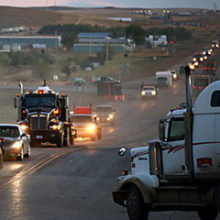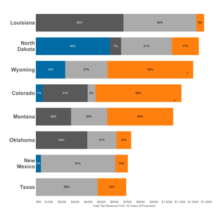Monitoring can help local governments better understand the socioeconomic impacts caused by energy development, and support requests to industry and state government for assistance to implement appropriate mitigation. Effective monitoring also is an essential part of adaptively managing drilling activity to minimize negative impacts while maximizing benefits.
Unfortunately, no universal system for measuring these impacts currently exists. At the federal level, while socioeconomic impact assessment is required by land use planning laws, it is generally limited to pre-development assessments that rarely occur on an ongoing basis. In addition, few state laws require ongoing impact assessments, and many communities where fracking takes place do not have access to standardized, ongoing data collection and analysis of social and economic impacts.
To help fill this lack of information, Headwaters Economics commissioned two case studies (one on Sublette County, WY and one on Garfield County, CO) by academic experts that provide suggestions for how make socioeconomic monitoring effective and efficient. We recommend what data to track along with ideas for how to approach and develop monitoring protocols to help planners, local leaders, industry, and community members understand and respond to the social and economic impacts of a high intensity industrial activity like fracking.
Summary
Horizontal drilling and hydraulic fracturing technologies (“fracking”) have resulted in a dramatic increase in oil and natural gas production in the U.S. These technologies require more wells to maintain production than comparable conventional oil fields. This expands potential employment, income, and tax benefits, but also heightens and extends public costs. As fracking opens or intensifies in many parts of the country, there is an increasing need to monitor and asses the impacts of this energy development on local communities.
The current lack of monitoring can lead to confusion, competing claims, or inaction. For example, significant media and public attention often is directed to opposing assertions about employment, housing, and transportation impacts of oil and gas drilling, especially around new proposals for drilling.
When using accepted practices and done systematically, measuring socioeconomic impacts can help communities in two ways. First, it can validate community and local government requests for impact mitigation to offset the need for increased road maintenance and construction, housing, police work, or other costs created by energy development. Second, monitoring can inform adaptive management of the pace and scale of drilling activity to help minimize negative impacts while maximizing benefits.
What to Monitor: Five Categories
Below we offer a brief description of a five categories of impacts most common to areas experiencing oil and gas development and a general overview of the kinds of data that are available.
Population growth & worker residency patterns
Large influxes of transient workers are a key driver of the housing, social service, and infrastructure demands that can overwhelm energy boomtowns, especially in rural areas. Understanding short- and long-term population growth, along with where workers actually reside, is important to state and local governments as they evaluate how much and where to expand infrastructure and services.
Population data are readily available from the U.S. Department of Commerce’s Census Bureau. For smaller populations such as rural counties or small towns, however, these data may lack necessary accuracy or only be available annually. It may be possible to supplement U.S. Census Bureau data from sources such as Internal Revenue Service data on changes in residency.
Ultimately, industry employers are the best source of data on worker residency. Few state and no federal data sources accurately track worker residency at the dynamic time scales characteristic of oil and gas development. Colorado is unusual in that it has an effective system for collecting information on oil and gas workers because some state energy revenue distribution formulae are tied to worker residency patterns.
Employment, personal income, and local business effects
Researchers have struggled to understand how intensive energy development such as fracking affects local economies in the short and long term. Important trends to monitor include changes to the total number of jobs and businesses, the composition of business activity by sector, changes to personal income, and average wages by sector. These data can help states and communities understand which types of businesses may be most vulnerable to energy-related economic impacts and guide how and where to direct support before, during, and after boom periods.
Key federal sources of data on employment and wage trends at the level of counties include the U.S. Department of Commerce’s Regional Economic Accounts and the Department of Labor’s Quarterly Census of Employment and Wages. These data are especially useful in considering trends over time. Supplementing these public datasets with original data collected locally also is important for understanding oil and gas development impacts. Original data collection can involve surveying local businesses or employees. The data collection effort itself has the potential to build local social and political capital and increase mitigation or adaptation.
Cost of living and housing
An increasing cost of living disproportionately impacts those whose wages do not rise with the growth in energy activity and is a frequent concern in energy development areas. Individuals on fixed incomes are vulnerable to rising housing costs, and high costs of living pose a problem for employers seeking to recruit and retain new employees in non-energy sectors. Conversely, the oversupply of housing during downturns in drilling activity can create local dilemmas in both the public and private sectors.
The U.S. Department of Commerce’s Census Bureau provides data on housing occupancy, type, cost, and affordability. However, like population data, these data for small communities may not be adequate to track changes on a yearly basis (the rate of change often affecting energy development). In these situations, maintaining locally-collected data about housing availability and cost may be an important supplement. Most states collect housing data on a periodic basis. Another option is to work with realtors to collect information on housing and rental availability and costs.
Service, infrastructure, capacity, and revenue
While energy development can be associated with new tax revenue, the ability to direct adequate amounts of revenue to the appropriate jurisdiction to best address impacts, and at the right time, is a common problem in areas that host energy development. Local governments often spend significant time and energy making the case for fiscal support from state government and industry. The growing need for police, fire protection, roads, water treatment, landfills, and other government activities all can be costly and grow dramatically during a period of energy development. Accurate and strategic fiscal reporting can be essential for effective local government requests for assistance with these increased costs.
Quality of life and other local concerns
Engaging the public in conversations about local assets that are valuable socially and economically is critical to an effective monitoring program. Understanding what these assets are—whether favored hunting areas, trout streams, viewsheds, or other resources—and then committing to monitoring the health and condition of these assets in a systematic way over time is important to adjusting or reforming energy development to protect locally prized areas or amenities.
How to Approach the Task of Monitoring
The following strategic considerations apply to developing an approach and process for monitoring social and economic impacts.
Timing and continuity
The most effective monitoring programs collect baseline pre-development data and continue to gather data even after energy development slows down. Today, many monitoring efforts operate only for a short time, and it is difficult to utilize these limited data effectively to implement needed mitigation or reforms.
Coordination
It often is most efficient to assign the task of data aggregation and analysis to one office that covers an entire energy development area rather than splitting the tasks among many jurisdictions. This allows for pooling of technical resources with clearer lines of authority and accountability. Consolidating data also can help uncover trends or connections across a broader area and is less likely to be interrupted. In addition, coordination between political jurisdictions is important because the impacts of drilling may be shared by larger areas that have a stake in effective monitoring and mitigation.
Engagement and transparency
It is not always necessary to engage a formally-trained consultant to execute data collection, although third parties can help think through technical issues such as survey design. Some datasets must be collected locally, and the most informative survey efforts may be those designed and executed by the community, for the community. This also can lead to fewer “closed doors” or the perception that some stakeholders have more influence than others.
Funding and clear goals
Rural areas often lack sufficient resources on their own for monitoring, and it may be especially difficult to provide resources necessary to establish baseline conditions or conduct adequate follow up monitoring, mitigation, or adaptation. To supplement limited local funding, communities should seek out alternative sources of financing wherever possible—whether from academic institutions, state governments, foundations, or a combination of these and other sources. Setting clear, achievable goals helps to maximize limited resources; while also managing expectations for what can be accomplished.
Monitoring can help local governments better understand the socioeconomic impacts caused by energy development, and support requests to industry and state government for assistance to implement appropriate mitigation. Effective monitoring also is an essential part of adaptively managing drilling activity to minimize negative impacts while maximizing benefits.




